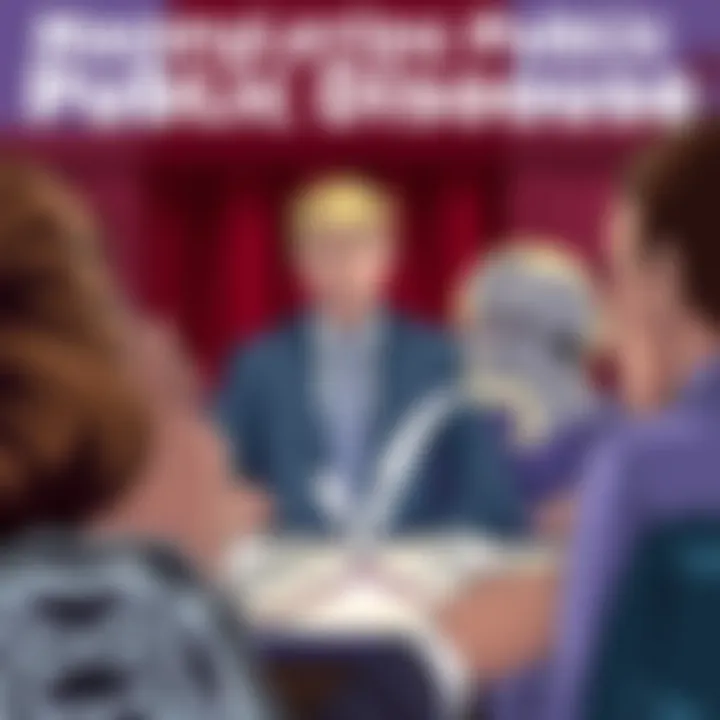Understanding Doubt: Insights from Chapter One of Merchants of Doubt


Intro
Chapter One of Merchants of Doubt sets the stage for an intricate analysis of how skepticism thrives in our public discourse. The authors, Naomi Oreskes and Eric Conway, peel back the layers of historical events and figures, illustrating how doubt can be artfully wielded as a weapon. This chapter isn't just a prelude; it's a clarion call for readers to understand the patterns and forces that drive misinformation in science and policy discussions.
The discussion on skepticism in this chapter traverses through significant moments in history, where scientific consensus has been exploited by political or economic interests. By demystifying the actors involved in this drama, Oreskes and Conway invite the readers into a dialogue about how these manipulations affect our perception of truth today. Their work showcases the tug-of-war between the quest for knowledge and the competing narratives that shadow it, ultimately shaping public opinion and policy.
In the backdrop of an era characterized by rapid information exchange, the authors highlight the dichotomy between genuine scientific inquiry and duplicitous dissent. They reveal how the corridors of power, intertwined with scientific discourse, spawn a culture where uncertainty can be strategically mobilized to serve ulterior motives. This chapter thus lays a foundation for comprehending the current landscape of misinformation.
One might ponder, why should we invest time in exploring this chapter? The answer lies in its relevance. As we navigate the cacophony of information available in the modern world, understanding the origins of skepticism becomes crucial. With the same questioning of official narratives that can drive scientific advancements, we also see the potential for misuse, creating confusion and disinformation. Recognizing these dynamics is imperative for anyone engaged in decision-making processes, whether in policy, education, or everyday life.
"Doubt is a twin of inquiry; however, it can become an adversary when draped in agenda."
Equipped with insights from Chapter One, readers can develop a sharper lens through which to dissect the complexities of public discourse surrounding science and ideology. This chapter not only probes the nature of doubt but urges its audience to question the stakes involved. The journey through Merchants of Doubt beckons a closer evaluation of how scientific truths may be compromised and what this means for our collective future.
Foreword to Merchants of Doubt
The exploration of Merchants of Doubt serves as a pivotal entry point for understanding how doubt is skillfully cultivated and wielded within the realms of science and public policy. This book is not merely a collection of passages; it’s a lens through which we examine a reality where misinformation has become a common currency, influencing policies and public opinion. The importance of this topic lies in its capacity to provoke critical thinking about how knowledge gets shaped in a society that simultaneously celebrates scientific advancement and grapples with its complexities.
Overview of the Book's Purpose
At the heart of the book is a clear intention: to expose the tactics employed by those who benefit from perpetuating ambiguity. The authors illuminate the ways in which specific groups manipulate scientific uncertainties to foster skepticism—often for economic or political gain. By dissecting these actions, the book aims to enhance the reader's appreciation of the mechanics behind public mistrust in science. It emphasizes that the conflict between established scientific consensus and emerging doubts is not accidental; rather, it has been carefully engineered through various historical events and contemporary debates.
Authors and Their Backgrounds
Naomi Oreskes and Erik M. Conway, the authors of Merchants of Doubt, are not mere casual observers of this discourse. Oreskes, a historian of science, brings a wealth of insight into how scientific data gets interpreted and presented, while Conway complements this with his expertise in the intersection of history and policy. Their collaborative work is rooted in solid academic foundations, alongside a vested interest in public understanding of science. They employ a blend of well-documented history and poignant case studies, which serve to enrich their analysis and helps to underline the urgency of addressing the manipulation of scientific discourse.
“Doubt is a powerful instrument. When wielded correctly, it can obliterate even the most solid truths.”
In summary, the introduction to Merchants of Doubt sets a critical stage for delving into the intricate threads that weave together science, ideology, and public perception. By questioning the motives behind the spread of doubt, readers are encouraged to critically reflect on the implications of misinformation within their own societal contexts, and how it can sway public health, environmental issues, and overall social trust.
Historical Context of Scientific Debate
The historical context of scientific debate is crucial in understanding the themes presented in Merchants of Doubt. It acts as the backdrop against which key arguments and ideas unfold. The evolving relationship between science, society, and politics suggests that the complexities surrounding scientific discourse are deeply rooted in history. By peering into the past, we grasp how skepticism has been wielded like a double-edged sword, both as a means of progress and as a tool for manipulation. Delving into this historical framework enables us to appreciate the myriad forces that perpetuate doubt and confusion in contemporary discussions.
The Role of Science in Society
Science, at its core, serves as a fundamental pillar of knowledge in society. Throughout history, it has not only transformed our understanding of the world but also shaped the way we address pressing challenges. However, the public perception of science can be precarious.
- Skepticism and Trust: Trust in scientific institutions varies, often influenced by cultural, political, and personal beliefs. When the public lacks faith in scientific findings, it can lead to a chasm between scientific communities and society at large.
- Science as a Social Construct: Science is not merely a collection of facts; it is a social construct influenced by the people who conduct it. Political agendas and economic incentives can steer research directions, broadening the chasm between objective science and public understanding.
The historical context reveals that science has been used to both enlighten and confuse. When detrimental ideologies hijack scientific claims, irrevocable damage can occur not just to the credibility of the scientific community, but also to society's health and welfare.
Key Historical Episodes of Doubt
History is replete with episodes where doubt was sown into the public psyche concerning scientific matters. By examining these key moments, we understand how misinformation can spiral out of control.
Some notable historical events include:
- The Tobacco Industry's Deception: In the latter half of the 20th century, tobacco companies famously cast doubt on the link between smoking and cancer. Significant funding was channeled into research that questioned these connections, leading to public confusion.
- Climate Change Denial: More recently, the discourse surrounding climate change has been marred by strategies aimed at discrediting scientific consensus. Debates have evolved not just in the political arena but in educational settings, creating a dangerous ripple effect of misinformation.
"Doubt is an essential part of human progress, but when it navigates through the lens of commerce and politics, it can be weaponized to serve specific interests rather than truth."
The integration of these historical examples serves to illustrate not only how doubt-wielding influences have operated in past circumstances but also foreshadows how they may continue in our current milieu. As we proceed in this exploration, understanding these contexts reminds us that skepticism can be beneficial, but only when grounded in a genuine pursuit of knowledge.
Intro to Key Concepts


In Chapter One of Merchants of Doubt, the foundation is laid for understanding how skepticism and doubt are constructed within public discourse. This section tackles critical concepts that are essential for grasping the broader implications of the book's themes. The key ideas presented here will make clear how influential figures manipulate uncertainties in science, and the consequences that unfold as a result.
Understanding these key concepts serves multiple purposes. For one, it equips readers with the tools to critically assess the information they encounter regarding scientific matters. Moreover, it sheds light on the psychological mechanisms that drive human behavior towards skepticism and distrust. By unraveling these intricate dynamics, readers can better navigate the murky waters of misinformation and propaganda that saturate contemporary discussions on scientific issues.
Definition of 'Merchants of Doubt'
The term "Merchants of Doubt" refers to individuals or organizations that engage in tactics to sow confusion and skepticism about established scientific knowledge. These entities often operate in the shadows, leveraging uncertainties to cast doubt on consensus viewpoints, particularly in controversial fields like climate science or public health.
A prime example is the tobacco industry, which, for decades, employed scientists and public relations experts to downplay the health risks of smoking. By questioning the validity of scientific evidence linking cigarettes and cancer, they perpetuated a cycle of doubt that hindered public understanding and policy change. This kind of behavior is a hallmark of what the authors refer to as the "merchants of doubt."
Although the direct resistence against scientific consensus may seem sinister, it's often couched in the language of concern for debate or discourse. This creates a facade of legitimacy around what is, in many cases, misinformation that serves specific interests. Consequently, recognizing these tactics is crucial for the public, as it empowers individuals to discern genuine scientific discourse from frivolous denial.
Psychology of Doubt and Distrust
Doubt and distrust are not merely products of rational evaluation; they are deeply embedded in human psychology. The psychology of doubt revolves around how people evaluate competing narratives, especially in situations where information is ambiguous or conflicting. Factors such as emotional resonance, cognitive biases, and social influences heavily shape these perceptions.
Humans are wired to be skeptical, a trait that has evolved as a survival mechanism. When faced with new or complex information, particularly in high-stakes scenarios, individuals often default to questioning its validity. This innate skepticism becomes a double-edged sword: while it can safeguard against misinformation, it can also lead to unwarranted doubt toward credible scientific evidence.
Moreover, repeated exposure to conflicting messages can fuel a sense of distrust. For instance, if a scientific consensus emerges but conflicting viewpoints are continuously amplified in media, many may adopt a stance of skepticism. The challenge lies in navigating this sea of information without succumbing to paralyzing doubt.
The intersection of psychology and public discourse profoundly affects how society responds to scientific findings. By grasping these psychological underpinnings, readers can begin to unfurl the layers of doubt that have poisoned the well of public understanding. Understanding the motives behind skepticism serves not only to contextualize current debates but also to foster a more well-informed public capable of separating fact from fiction.
Narrative Style and Techniques
The narrative style employed in Chapter One of Merchants of Doubt is crucial for conveying its significant themes about the complexities surrounding scientific discourse and the manipulation of public perception. The way information is presented, through a blend of anecdotal storytelling and empirical evidence, creates an engaging narrative that resonates with readers, thus enhancing the overall impact of the text. By weaving in narratives that are relatable and profound, the authors invite their audience to consider the outlined issues not merely as abstract concepts but as tangible realities that affect daily lives.
Use of Anecdotes and Case Studies
Anecdotes and case studies serve as powerful tools within the chapter, breathing life into theoretical discussions. By providing relatable stories, the authors humanize the complex ideas surrounding skepticism and doubt. For instance, when discussing the public’s reaction to climate change science, a narrative might employ the personal journey of a scientist facing backlash from corporate interests after publishing research on environmental impacts. This approach not only illustrates the real-world consequences of scientific findings but also makes the material approachable for everyday readers.
- Anecdotes can:*
- Highlight individual experiences that reflect broader societal issues.
- Create emotional connections that drive the point home.
- Instantaneously draw the reader’s attention, making it easier to digest complex data and studies.
In the context of the book, these narratives serve to underline the pervasive influence of doubt created by vested interests, allowing the audience to see individuals, not just statistics. A well-chosen story can transform an entire argument, making the chapter’s core themes not just digestible but impactful. Regardless of the background, whether one is a student or a seasoned professional, these anecdotes can illuminate the chapter's darker nuances, fostering empathy and understanding amid skepticism.
Integration of Scientific Research
The effective integration of scientific research within Merchants of Doubt sets the framework for its arguments, providing rigorous support to the narratives presented. The authors take care to reference empirical studies from respected journals and institutions, which enriches the text’s credibility. By juxtaposing anecdotes with solid scientific evidence, the authors underscore the contrast between genuine scientific inquiry and manufactured skepticism.
- Several key functions emerge from this integration:
- It establishes a factual basis for claims made within the book, reinforcing its arguments.
- Helps the audience navigate through the murky waters of misinformation prevalent in public discourse.
- Provides a foundation for further exploration as the reader engages with both the data and the personal stories shared.
Ultimately, it is the combination of these narrative elements that enables readers to grasp the gravity of the issues at hand, revealing not just what is at stake but why it matters. As readers move through these dynamic sections, the clear presentation of scientific data tied to compelling personal narratives forms a compelling tapestry that illustrates the far-reaching consequences of doubt in society.
"Doubt is a shadow cast over society, and understanding its roots is the first step towards illuminating the truth."
Through this approach, Chapter One hints at the various threads that will be explored in greater depth throughout Merchants of Doubt. The integration of narrative style and scientific research creates an instructive yet engaging guide that prepares the reader for the complexities ahead.
Notable Figures and Their Influence
The exploration of Chapter One of Merchants of Doubt naturally leads to a discussion about the significant individuals who shape the discourse surrounding scientific debate. These notable figures play an essential role in molding public perception and policy decisions—often bringing their biases and interests to the forefront. Understanding their influence allows us to peel back the layers of how doubt and skepticism are carefully orchestrated in the name of science.
Key Scientists and Influencers


Within the realm of scientific debate, certain figures emerge as key players, whether they are scientists or those representing various industry interests. Figures like Frederick Seitz, who was a prominent physicist and served as the president of the National Academy of Sciences, played a pivotal role in discrediting scientific consensus on several key topics, including climate change. His actions often illustrate how a respected voice can sway public opinion to align with specific interests.
Another noteworthy individual is Richard Lindzen, an atmospheric physicist who has often debated climate science realities. His arguments, framed in scientific rhetoric, have raised doubts that persistently trickle into public discourse. Such scientists wield the power to obscure more than illuminate. Their credibility can often mask underlying motives, crafting narratives that align more with their professional ties than with empirical evidence.
Moreover, we cannot overlook the impact of lobbyists who, while they might not wear lab coats, have a substantial footprint in the scientific conversation. These individuals or organizations represent sectors like fossil fuels or tobacco. They employ strategies rooted in science yet mask their true agenda behind complex theories and studies to foster skepticism in more sound scientific propositions.
Thus, the intertwining of these figures, with their distinct yet complementary agendas, creates a tapestry of influence that reinforces doubt rather than achieving clarity. Understanding their roles is critical for discerning how scientific dialogue can be manipulated.
Impact of Policy Makers
The role of policy makers cannot be underestimated when examining the intersection with notable scientific figures. These individuals help craft the legal frameworks and societal responses to scientific claims, often swayed by the data—and narratives—presented by scientists who might have a vested interest. A prime example includes the influence of lawmakers who align with the fossil fuel industry, often leading to legislation that delays environmental policies in favor of profit.
Consequently, policy makers can amplify the skepticism propagated by some scientists. They may use rhetoric that echoes the doubts presented, shaping laws that hinder scientific advancements and delay actions on pressing issues like climate change and public health. The clash of politics and science often creates a chasm, making it more difficult for the public to distinguish between valid critique and opportunistic manipulation.
All sections of an article: [[
Underlying Motivations for Doubt
Understanding the underlying motivations for doubt is crucial in dissecting the thesis of Merchants of Doubt. This chapter exposes the intricate ways in which economic and political factors interplay to shape public skepticism towards scientific conclusions. Recognizing these motivations allows us to see beyond the surface of debates and understand the forces steering public perception and policy. The manipulation of doubt isn't merely an academic curiosity; it has real-world consequences that touch every facet of our lives.
Economic Interests
Economic interests lie at the heart of many doubts cast on scientific findings. Companies or industries that stand to lose financial capital often engage in campaigns to undermine scientific consensus. For instance, the tobacco industry's historical denial of health risks related to smoking serves as a prime example. The staggering profits from tobacco sales outweighed the potential costs of acknowledging their product's dangers. Companies, like Philip Morris, hired consultants and scientists to create a veneer of uncertainty about the health impacts, a tactic that effectively stifled meaningful regulations for years.
Moreover, following the same pattern, the fossil fuel industry has invested heavily in sowing discord about climate change to protect their interests. By funding research that calls the consensus into question, they give the impression that there is a legitimate debate ongoing, thus delaying critical climate action.
“Economic motivations often lead to the deliberate construction of doubt, wrapping it in a scientific smokescreen that complicates public understanding.”
Here’s a closer look at how economic interests have facilitated doubt:
- Funding Research: Industries often sponsor studies that align with their agendas, which might skew results.
- Public Relations Campaigns: Well-funded campaigns can effectively drown out the message from the scientific community.
- Lobbying: Influencing policy through lobbying ensures that scientific findings are not effectively translated into law, maintaining the status quo.
Political Agenda
On the political spectrum, the manipulation of doubt is equally impactful, often shaped by ideological divides. Politically motivated doubt distorts public conversations, creating an environment where misinformation breeds. Politicians who benefit from certain narratives may leverage doubt to rally their base or discredit opponents. This is vividly illustrated in debates over climate change, where political parties align themselves with varying stances based on their larger agenda, irrespective of scientific consensus.
The politicization of science also extends to public health. During health crises, such as the COVID-19 pandemic, political motives can overshadow science-based responses. Conflicting messages from different political leaders can lead to public confusion and disillusionment, as seen in the division over mask-wearing and vaccination, where personal freedoms were pitted against collective health expertise.
Key elements of how political agendas foster doubt include:
- Polarization: Certain political affiliations can lead to a dismissal of scientific consensus if it contradicts party values.
- Scapegoating Science: Politicians can use scientific findings as tools to distract from their failings or deepen societal divides.
- Regulatory Rollbacks: Efforts to dismantle environmental or health regulations often coincide with a concerted effort to downplay the science.
Together, these economic and political motivations create a web of doubt that complicates the public's ability to recognize the truth. This exploration in Merchants of Doubt lays the groundwork for understanding how vested interests shape discourse and, ultimately, influence actions taken on pressing societal issues.
Consequences of Misplaced Doubt
The concept of misplaced doubt carries significant weight in the framework of Merchants of Doubt. This section illuminates how skepticism, rather than being wholly beneficial, can spiral into severe consequences, particularly in the realms of public health and environmental stewardship. Understanding these repercussions is crucial. Misinformation not only clouds judgment but can lead to catastrophic decisions that echo across generations. Unhealthy skepticism leads to decisions that erode trust in science and can have disastrous effects.
Impacts on Public Health
First, let��’s look at how misplaced doubt manifests in public health. When scientific consensus around health issues is undermined, the ramifications can be dire.
- Vaccine Hesitancy: One prominent example is vaccine hesitancy, which has gained traction due to misleading information propagated by various interest groups. Misguided beliefs about vaccine safety fueled by doubt have caused preventable outbreaks of diseases thought to be under control, like measles and whooping cough.
- Nutrition Misconceptions: Furthermore, conflicting dietary advice has driven misinformed choices about nutrition. Consider how the sugar versus fat debate flared up intense skepticism around nutrition science. The resultant confusion leaves individuals vulnerable to unhealthy dietary habits, which exacerbate chronic health conditions.
The impact extends globally. Countries grappling with infectious diseases risk having their population's health crippled due to the public's lack of trust in vaccines or health authorities. In essence, misplaced doubt fosters an environment where misinformation thrives, and the repercussions can be a rolling stone that gathers no moss, affecting the collective health of society.


Environmental Considerations
In addition to public health, the consequences of misplaced doubt also seep into environmental considerations. The denial of climate change is a vivid case where skepticism, masked as caution, obscures urgent action.
- Climate Change Denial: Numerous organizations have sown seeds of doubt about climate change, presenting it as an unproven theory or a natural occurrence rather than a consequence of human activity. This interference disrupts the implementation of critical policies and regulations needed to curtail greenhouse gas emissions.
- Regulation Frustration: The backlash against environmental regulations based on dubious claims that they harm economic growth is another facet of this phenomenon. Companies with vested interests often feed these doubts to keep regulations at bay, leading to long-term environmental degradation.
The long-lasting effects of disregard toward scientifically backed environmental policies could result in catastrophic climate consequences, leading to loss of biodiversity, extreme weather patterns, and diminished natural resources.
Quote: "When doubt is erected as a barrier between evidence and action, we end up in a quagmire where progress becomes an uphill battle."
Strategies for Mitigating Doubt
Chapter One of Merchants of Doubt stresses the significance of strategies to mitigate doubt in contemporary public discourse. In an age marked by rampant misinformation, it’s crucial to implement ways that restore faith in science and expertise. Recognizing the tactics employed by those who spread doubt empowers individuals and institutions to counteract these narratives with clarity and effectiveness.
Importance of Transparent Communication
Transparent communication stands as a cornerstone in the battle against doubt. It fosters trust between scientists and the public, dismantling the barriers that skepticism erects. When information is clearly laid out, and the reasoning behind scientific conclusions is articulated without jargon, it increases accessibility for everyone, not just academics.
- Clarity over Complexity: Simplifying complex concepts allows the average person to grasp the essential truths without the fog of technical language. For instance, when the public hears about climate change, the message should focus on tangible effects—like recent hurricanes and heatwaves—rather than just statistics from research papers.
- Engagement with the Audience: It's not sufficient to passively deliver facts; scientists need to engage with audiences. Social platforms serve not just as tools for dissemination but also as spaces for dialogue. Legitimate engagement can humanize scientists and make the discourse more relatable.
True transparency requires acknowledgment of uncertainties. When experts admit what they don’t know, it builds authenticity. All these points help create a reservoir of trust that combats the encroachment of doubt.
"Fostering an environment where questions are encouraged can lead to deeper understanding than mere acceptance of facts."
Educating the Public on Scientific Literacy
Educating the public on scientific literacy holds great weight in mitigating doubt. Scientific literacy is more than just knowing facts; it’s about understanding the process of science itself – how hypotheses are formed, tested, and revised over time. This can decrease vulnerability to misleading information. Here are strategies for enhancing scientific literacy:
- Curriculum Reforms: Introducing robust science curricula in schools can lay a solid foundation. Courses should emphasize critical thinking and the scientific method, not just rote memorization.
- Public Workshops and Forums: Events aimed at various demographics can demystify science. By engaging communities in discussions led by experts, misconceptions can be addressed directly. These activities offer clarity about scientific findings and processes, promoting a culture of informed skepticism rather than unwarranted doubt.
- Utilizing Technology: In a world intertwined with technology, leveraging platforms like online courses and webinars can reach wider audiences. The use of social media for bite-sized scientific snippets can also prove effective. The goal is to pique interest, leading individuals to seek deeper understanding.
Through these methods, scientists and educators can cultivate a populace that feels empowered, asking informed questions rather than succumbing to fear-mongering and exaggeration. Ultimately, promoting scientific literacy is akin to giving individuals the keys to decode the complexities of information they encounter daily.
Ending of Chapter One
The conclusion of Chapter One holds significant weight in the overall narrative of Merchants of Doubt. This section acts as a pivotal hinge, where the concepts of skepticism and manipulation are not simply reiterated but instead synthesised into broader implications. It compels readers to recognize the intricate ties binding scientific inquiry, ideology, and political maneuvering. By summing up the key discussions and theoretical foundations laid earlier in the chapter, the conclusion serves to crystallize the complex relationship between doubt and public understanding of science.
Understanding this relationship is crucial for anyone navigating today’s landscape of information. The implications for policy, education, and public perception are monumental. Readers are left with a nuanced arsenal of knowledge — one that encourages critical thinking and skepticism not just of science but also of the motivations behind varying narratives.
Summarizing Key Takeaways
The takeaways from Chapter One are multi-faceted:
- The manipulation of doubt has historical roots and is perpetuated by vested interests.
- Skepticism is not inherently negative but can be weaponized to undermine legitimate scientific discourse.
- The interplay between ideology and science shapes policy decisions and societal beliefs.
- Acknowledging these dynamics is essential for fostering informed public discourse and decision-making.
The chapter deftly illustrates how these themes converge, providing readers with a clear lens through which to view contemporary debates around science and its societal role. This understanding is not merely academic; it's a toolkit for recognizing manipulation in media, politics, and even personal beliefs.
Setting the Stage for Further Exploration
As the curtain closes on this chapter, it simultaneously sets the stage for deeper inquiry into the subjects raised. Future discussions can venture into:
- Specific historical examples of doubt manipulation in various scientific fields, such as climate change or public health.
- The roles of different stakeholders in perpetuating doubt, from scientists themselves to policymakers and the media.
- Strategies for counteracting misinformation and promoting scientific literacy in a broader sense.
Readers are encouraged to ponder, how do they fit into this narrative? Being equipped with awareness allows them to better argue against misinformation and engage in conversations that promote understanding rather than division.
The journey doesn’t end with this chapter; it’s a gateway into a more profound examination of the delicate balance between skepticism and trust in the arena of knowledge and belief.
"The struggle to discern truth in an age of misinformation is not just scientific; it is deeply personal and societal."
For those ready to delve deeper, resources such as Wikipedia on scientific skepticism and Britannica articles on the history of science offer a greater well of information.
With each turn of the page, the reader not only learns but also becomes a participant in shaping how science and doubt will coexist in future narratives.















